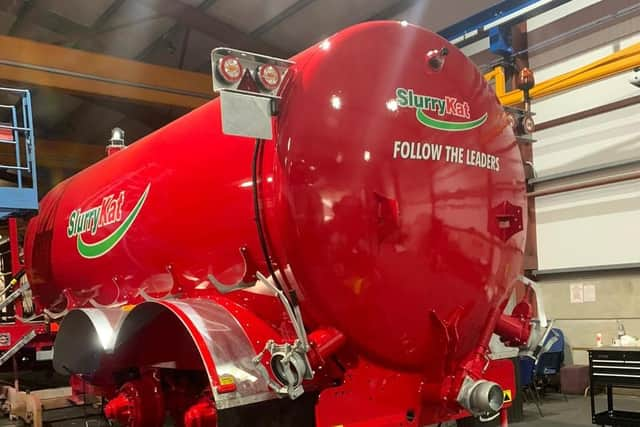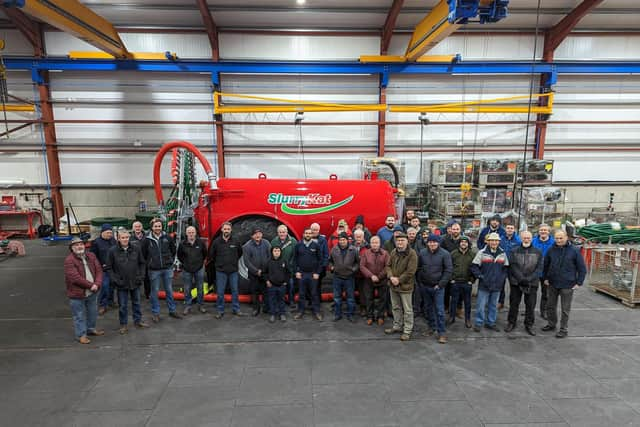I Agr E Branch members pay visit to SlurryKat in Co Armagh
and live on Freeview channel 276
This included a conducted illustrated tour by Jonathan Hassin (operations manager) and Michael Crozier (design engineer).
They covered many aspects from Computer Aided Design of innovative products through the use of up to date technology and quality materials to manufacturing of the now well known range of SlurryKat machinery.
Company history


Advertisement
Advertisement
From the 1990s company founder Garth Cairns began his farm contract business providing local farms with silage harvesting and slurry spreading services. This experience, coupled with his own design and fabrication skills, led to acquisition of the SlurryKat brand which, by 2007, had commenced manufacturing equipment for the umbilical slurry spreading system. Since then SlurryKat has developed its own new designs and innovative concepts with special emphasis on the safe, efficient and environmentally friendly utlilisation of farm slurry. Cairns Contracting continues to provide its services to local farmers. This is an effective way to evaluate machine performances in local conditions and to stimulate new ideas for production. SlurryKat’s own agricultural, land adjacent to the factory site, has high-volume slurry storage facilities and is used as a test base for machine design, research and development.
The range
SlurryKat machinery product range now includes umbilical pumping and spreading (dribble bar, trailing shoe, soil injection and aeration) systems. Hose reel management equipment, high capacity pumps, lagoon mixers, tank mixing agitator pumps, mobile buffer tanks and tankers. Tanker sizes range from 7,000 to 25,000 litres and offer a wide range of specialist options for both transport and spreading.
SlurryKat also manufacture a range of trailers including tippers for grain/silage, flatbeds, low-loaders, dumpers and general purpose types. There is also a range of handling implements for tractors/telehandlers/loaders including buckets. shear grabs and brushes.


The main emphasis for our tour was on the manufacturing of the tankers and field slurry spreading systems.
Advertisement
Advertisement
SlurryKat proudly states its aim to be “The world’s leading slurry handling equipment manufacturer” and are active registered members of the ISO 9001 Quality Management System which applies to both its manufacturing processes and company management style.
The designs for all their machines are held on computer aided design systems. They are part of the up to date technology system directing the choice, use and processing of the materials. For bespoke designs, such as the tankers, the system keeps a specific record of the details of each customer order through the production process and for ongoing warranty and spare part identification purposes.
A manual is prepared for each machine and accompanies it through from design to completion.
We saw how the sheet components, of chosen specification, are precision cut using a fibre-laser cutter before being folded into the required shapes. In 2021, SlurryKat installed its own liquid nitrogen gas generator. The technique supports clean precise metal cutting and replaces the need to bring in oxygen.
Advertisement
Advertisement
Examples of the press-formed tanker chassis systems were displayed as well as how all of the pre-formed parts, for each specific machine, are brought together in a cage collection for the convenience and efficiency of the subsequent welding assembly process. The 6mm thick tanker bodies are rolled, in-house, before the detailed internal and external welding processes take place to add the tank ends internal baffles and other components. With the chassis/draw bar systems fitted it was interesting to see how the fabrication process continues with the tanker down side up. As the work progresses, it is handled and turned by a comprehensive system of overhead cranes and derricks to ensure operator safety and convenience. The high standards of health and safety in the work areas include high capacity fume extraction/ventilation and full air-supplied PPE wear for jobs in confined enclosed spaces for like the synergetic internal and external welding processes.
Preparation and painting
After all of the steel components have been welded on the tanker is placed on a wheeled sub frame to travel on a floor fixed rail track. This carries it to the modern high capacity shot-blast cleaning area where all surface imperfections, such as surface rust, are removed. After inspection, and any detail correction, the tanker moves into the high capacity heated paint spray booth. A special two pack primer is applied before several coats of acrylic gloss finish and the oven’s 85 degree C 1 hour holding process is completed. The most popular current colour is red, followed by black and then green. Terracota blue is also now available and the system is designed to permit other colour options of customer choice.
Still on its “railway” trolley, the tanker is then moved on for the fitting of its road wheels, non-metallic components. electrical systems, warning decals and distinctive “SlurryKat” logos.
Some of the other products, such as the frames for the umbilical spread booms have a galvanised finish. It was interesting to note that the weight of the 15m boom has been minimised by using a special strong type of steel.
Tanker specifications
Advertisement
Advertisement
Depending on customer requirements tanker specifications range from traditional vacuum-fill/pressure discharge “Panterra” machines with 7,000 to 20,000 litre capacities to the Premium Plus Super tankers (size range up to 25,000 l / 5,000 G). These are designed for intensive contract type work. Typical features include having both a Battoni Pagani vacuum pump for filling and a high capacity centrifugal Doda pump for pressure discharge. They are designed to carry a rear mounted SlurryKat spreading system with its hydraulically powered macerator/distributor feeding out via a dribble bar spreading boom up to 9 m wide. A trailing shoe type (up to 7.5m) is a further alternative. The umbilical spreading system is more environmentally friendly, than the tradition inverted spread-plate tanker, by its minimising of ammonia losses and so retaining more of the valuable N plant nutrients. It has now become a requirement to satisfy some environmental statutory schemes and the trend to use of the system continues.
Features across the entire tanker include recessed large flotation tyres, sprung drawbar, commercial spec axles/ braking system, anti-surge internal baffle system and heavy duty multi-leaf suspension.
Tractor mounted boom systems
The umbilical system, where slurry is pumped through a trailing hose to a tractor mounted traveling wide folding boom, is popular with contractors for high rate, continuous output work. The wide working widths (up to 15m) reduce wheelings and compaction compared to tanker only systems. Dribble bar booms are available up to 24m with trailing shoe versions up to 12m.
Slurry may be pumped directly and continuously to the spread boom from on-farm storage tanks. For locations more remote from the yard a mobile buffer tank can be placed at a field entrance and slurry delivered to it by ferry tankers. The SlurryKat buffer tank range includes capacities from 45 to 150 cubic metres. A tractor PTO driven centrifugal pump is normally used to pump the slurry to the boom applicator in the field. SlurryKat supply Doda chopper pumps with outputs from 150 up to 660 cubic metres/hour.
Advertisement
Advertisement
The pumping systems on the tankers and umbilical systems have inbuilt stone /debris traps to prevent damage.
The Intelligent Application rate control system is available for both tankers and umbilical systems. The operator can select the required application rate and the system will automatically adjust it if the forward travel speed changes. Where a nutrient sensor is available it is also now possible with ISOBUS equipped tractors to vary application rates in response to electronic field maps.
Following the tour of the impressive modern facilities I Agr E Branch Chairman Ken Gardiner thanked both Jonathan and Michael for sharing all their information so effectively and wished them, and all at SlurryKat, continuing success.
More details of all the SlurryKat products can be viewed on slurrykat.com